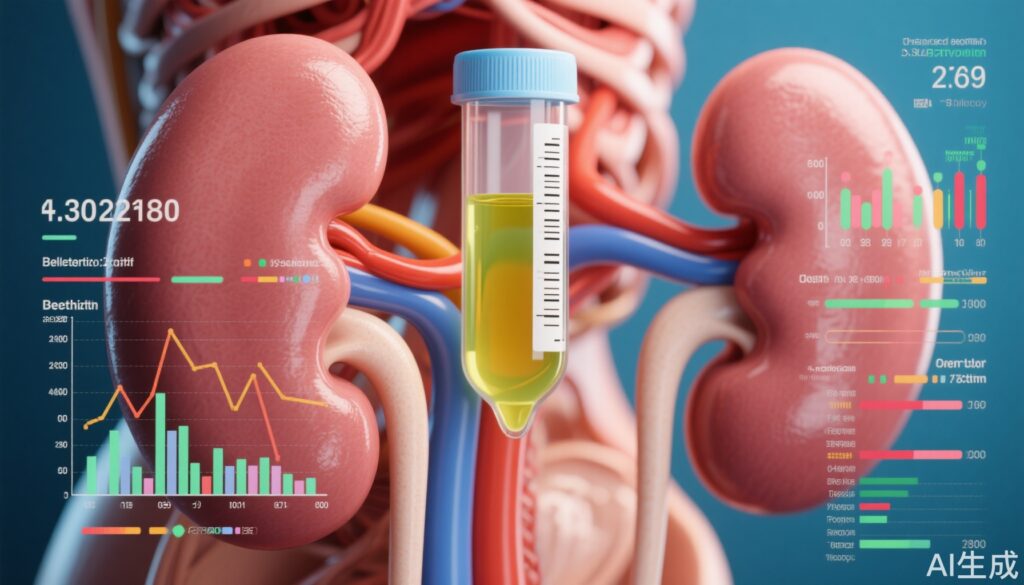Highlight
- Urine biomarkers measured during ambulatory acute kidney injury (AKI) are associated with subsequent kidney function recovery in hypertensive adults undergoing blood pressure treatment.
- Higher urine albumin-to-creatinine ratio and lower epidermal growth factor (EGF) levels predict nonrecovery of eGFR under standard blood pressure treatment.
- In intensive blood pressure treatment, higher urine α-1 microglobulin and lower EGF and kidney injury molecule-1 (KIM-1) levels are linked to nonrecovery.
- Urine biomarker profiles may help distinguish which patients experiencing serum creatinine elevations will have persistent kidney dysfunction, guiding management strategies.
Study Background and Disease Burden
Elevations in serum creatinine during antihypertensive therapy are common and pose clinical challenges, as they may signal acute kidney injury (AKI). Ambulatory AKI, detected outside of hospital settings, complicates treatment decisions because it is unclear if kidney function will subsequently recover. Tools enabling early differentiation between reversible and persistent kidney damage are limited. Acute and chronic kidney diseases cause substantial morbidity and mortality worldwide, and optimizing blood pressure control while avoiding progressive kidney impairment is paramount. Therefore, identifying predictors of kidney function recovery after AKI during outpatient blood pressure treatment is an unmet need.
Study Design
This study is a longitudinal analysis of 652 participants from the SPRINT (Systolic Blood Pressure Intervention Trial) cohort who developed ambulatory AKI during the trial. Ambulatory AKI was defined as an increase in serum creatinine of ≥0.3 mg/dL from baseline noted at either the 1-year or 2-year study visit. Participants had baseline and AKI-visit urine biomarker measurements.
Eight urine biomarkers indicative of glomerular and tubular health were measured and indexed to urine creatinine to control urine concentration variability. These included albumin, α-1 microglobulin, epidermal growth factor (EGF), kidney injury molecule-1 (KIM-1), among others. Participants were stratified by randomization arm into standard or intensive blood pressure treatment groups. The primary outcome was incomplete recovery of kidney function, defined as less than 50% recovery of estimated glomerular filtration rate (eGFR) 12 months post-AKI.
Key Findings
The average participant age was 70 ± 10 years with mean baseline eGFR of 62 ± 25 mL/min/1.73m², declining to 42 ± 12 mL/min/1.73m² at ambulatory AKI detection.
In the standard blood pressure treatment arm:
– Higher urine albumin-to-creatinine ratio was associated with increased odds of nonrecovery of eGFR (OR per 1-SD increase, 1.72; 95% CI, 1.10-2.70).
– Lower urine epidermal growth factor levels were inversely associated with nonrecovery (OR, 0.46; 95% CI, 0.26-0.79).
In the intensive blood pressure treatment arm:
– Higher urine α-1 microglobulin-to-creatinine ratio was linked with nonrecovery (OR, 1.45; 95% CI, 1.09-1.92).
– Lower EGF levels similarly predicted nonrecovery (OR, 0.62; 95% CI, 0.46-0.83).
– Lower KIM-1 levels were also associated with reduced odds of kidney function recovery (OR, 0.75; 95% CI, 0.59-0.96).
These associations suggest that markers of glomerular injury (albumin) and tubular dysfunction (α-1 microglobulin, EGF, KIM-1) measured at the time of AKI provide insights into the likelihood of kidney function recovery.
Expert Commentary
Current clinical practice mainly relies on serum creatinine changes to identify AKI, but this parameter alone cannot predict whether kidney function will recover, especially in the ambulatory setting. This study emphasizes the utility of noninvasive urine biomarkers to characterize the extent of glomerular and tubular injury underlying the serum creatinine rise.
The differential biomarker patterns according to blood pressure treatment intensity underscore potential pathophysiological nuances in AKI recovery. For example, lower urinary EGF, a marker of tubular regeneration and repair, was consistently associated with nonrecovery regardless of treatment arm, indicating its potential as a prognostic biomarker.
The exclusion of patients with diabetes and heavy proteinuria (>1g/day) limits generalizability, as these populations are at high risk for kidney disease progression. Further investigation into biomarker utility in these subgroups is warranted.
Integrating urine biomarker measurements with clinical data could personalize management by identifying patients at risk for persistent declines in kidney function, possibly guiding adjustments in antihypertensive therapy or closer monitoring.
Conclusion
Among hypertensive adults undergoing blood pressure treatment who developed ambulatory AKI, urine biomarkers indicative of glomerular injury and tubular dysfunction were significantly associated with subsequent kidney function recovery. Urine albumin-to-creatinine ratio, α-1 microglobulin, epidermal growth factor, and kidney injury molecule-1 measured at the time of AKI may help clinicians distinguish patients at risk for persistent kidney impairment. This biomarker-based approach promises to enhance determination of kidney recovery trajectories and optimize antihypertensive treatment strategies in outpatient settings.
References
Ascher SB, Katz R, Estrella MM, Scherzer R, Chen TK, Garimella PS, Bullen AL, Hallan SI, Wettersten N, Cheung A, Shlipak MG, Ix JH. Associations of Urine Biomarkers During Ambulatory Acute Kidney Injury With Subsequent Recovery in Kidney Function: Findings From the SPRINT Study. Am J Kidney Dis. 2025 Aug;86(2):155-165. doi: 10.1053/j.ajkd.2025.02.607. Epub 2025 Apr 21. PMID: 40268226.



